HIGHLINE notes
November 2024

A Christmas ice storm like no other, pg. 6
Bracing for the unpredictable, pg. 8


A Christmas ice storm like no other, pg. 6
Bracing for the unpredictable, pg. 8
Paul Matthys, president/CEO, Cass County Electric Cooperative

November is one of my favorite months. Hunting season is in full swing, the mosquitoes are gone, and people are beginning to prepare for the holiday season. November is also a time for thanks, and we have much to be thankful for.
Electricity is one thing we continue to be grateful for – it’s something we depend on daily for essential needs. Keeping the lights on, heating our homes, keeping our food cold, charging phones, and powering well pumps so we have running water are all essential needs that can’t happen without reliable electricity. You may remember the 2023 Christmas Day ice storm that left some without electricity for 11 days.
This reminds me of something else to be thankful for. Lineworkers and many other cooperative employees stepped up to the plate, working 12–15hour days, leaving their families during the holidays, and embracing the less-than-perfect working conditions to restore power to our members’ homes, farms, and businesses, and they deserve our thanks.
We occasionally must deal with an ice storm or windstorm, but we can be thankful that we are not going through what our cooperative families are experiencing in the southern part of our nation. The one-two punch of Hurricane Helene and Hurricane Milton left more than 3 million Americans without power, which continues as I write this article. We are thankful that we have cooperation among cooperatives, which is one of our seven cooperative principles. Electric cooperatives nationwide have sent mutual aid crews, equipment, and donations to the electric cooperatives and their families affected by the hurricanes. We are working with our statewide organization, North Dakota Association of Rural Electric Cooperatives (NDAREC), to coordinate assistance and donations.
Controlling expenses, embracing technology, and managing budgets are things we attribute to keeping your electricity rates stable. CCEC has not implemented a rate increase since 2017 despite inflationary pressures on our material costs. Over the past four years, the cost of our power poles has increased 173%, transformers are up 320%, wire up 40%, conduit is up 99%, and bucket trucks are up 24.5%. Another component that helps to keep rates stable – and something to be thankful for – is our load growth. We are fortunate to live and serve in areas that support economic development and growth. Over the past 20 years, we have added 1,600 accounts per year, on average. Load growth for cities, rural communities, and utilities has challenges, but overall, it is healthy for cost stability.
We’re grateful to have you as a member of Cass County Electric Cooperative, and we hope you feel the same. At CCEC, we’re committed to providing reliable service, managing costs responsibly, and giving back to the communities we serve. As always, our goal is to keep your power on 100% of the time. Wishing you and your loved ones a safe and joyful Thanksgiving!

As a local business staffed by your friends and neighbors, Cass County Electric Cooperative is finding new ways to make a difference –beyond delivering electricity. CCEC is #ProudToPower our community’s innovators, dreamers, and doers.
The Cass County Electric board of directors met in person on Sept. 24, 2024, and discussed the following topics:
• Moved to approve the September 2024 consent agenda of the regular board meeting consisting of minutes, monthly department reports, director expense report, and the August purchased power adjustment (PPA).
• Received the chairman’s report.
• President/CEO Paul Matthys gave the president’s report, providing updates from meetings and conferences attended.
• Moved to approve boardroom remodel project (new desk, some wall coverings, and cabinetry work).
• Moved to approve sponsorship in Innovate28, a joint effort between The FMWF Chamber and the Greater FargoMoorhead EDC to promote business expansion and retention, address workforce issues, attract new business,
and promote public policy.
• Received the August 2024 financial report.
• Received a report on electric vehicles and charging stations.
• Received a report on franchise fee changes.
• Received a report from the NDSCS Career Academy.
• Received a report from the joint Minnkota Power Cooperative/Square Butte board meeting.
• Received a report from the board/staff retreat.
• Moved to approve the September 2024 capital credit estate payments.
• Reviewed upcoming meetings and events.
• Moved the January board meeting to Friday, Jan. 31.
The next board meeting is Tuesday, Nov. 26, 2024.
Communications:
Morgan Bachelor
Jocelyn Lura Hovland
Printer:
Forum Communications Printing
Board of Directors: Paul White, Secretary
Douglas Anderson
Vanessa Kummer
Stacey Ackerman
Tom Seymour
Glenn Mitzel, Board Chair
Wendy Loucks
Kalvin Hoff, Treasurer
Terry Kraft, Vice Chair
Executive Staff:
Paul Matthys, President/CEO
Jodi Bullinger, VP of Engineering & Operations
Chad Brousseau, VP of Member & Energy Services
Chad Sapa, VP of Corporate Services & CFO
Tim Sanden, VP of Information Technology & CIO
Highline Notes (USPS 244-740) is published monthly by Cass County Electric Cooperative Inc., 3312 42nd St. S., Suite 200, Fargo, ND 58104. Periodicals postage paid at Fargo, North Dakota 58104, and at additional mailing offices.
Postmaster: Send address changes to Highline Notes 3312 42nd St. S., Suite 200 Fargo, ND 58104 © Copyright Cass County Electric Cooperative 2024. All rights reserved. Questions: 701-356-4400 800-248-3292 info@kwh.com Call Before You Dig: 800-795-0555 or 811 Cass County Electric Cooperative is an equal opportunity provider and employer. Information about the cooperative, articles of incorporation, bylaws and
Bob Schrader proudly donned a Vietnam Vet cap as he flipped through photo albums of his time serving in the U.S. Army. The 80-year-old was just 19 when he and his twin brother enlisted, fresh out of high school in rural South Dakota.
“You can see I was a grease monkey,” Schrader laughed, pointing to a portrait of his younger self in his aircraft maintenance uniform, standing alongside the tail end of a U.S. Army twin-engine Caribou transport plane. “They needed 14 people trained on multi-engine for the brand-new Caribou, so the top 14 people got the position. I was number 14. I just made it.”
Schrader served as assistant
crew chief and then crew chief of the Caribou 62-4149 for a year during the Vietnam War. Although it wasn’t his job to fly the plane – he oversaw aircraft maintenance and mission support – he remembers the steep ascent and descent of the war’s short 1,000-foot runways, for which pilots had to learn special techniques. “How to get over the bullets and get her down and land without smashing up the airplane,” Schrader said. “In Vietnam, we all had to know how to land it in case they [the pilot] got shot.”
Schrader and the Caribou 624149 crew left North Carolina’s Fort Bragg and headed east, first landing in Saigon on July 4, 1963. Their primary focus was transport, flying Vietnamese

soldiers throughout the valleys, and hauling food and ammunition where it was needed. The Vietnamese used “live weight” food, so the Caribou would often be loaded with live pigs, ducks, geese, and chickens in addition to rice.
“So, you always flew with the doors open to keep the…” he said, pausing with a grin. “I left the farm to get rid of the chickens.”
In March 1964, Schrader’s Caribou 149 was sent out for major maintenance, and he was given Caribou 593 in the interim. Two months later, a fellow crew chief, Don, asked Schrader to switch his short flight with Don’s long flight so that he could see a doctor about a back problem.

It was too late to reschedule their missions, so they simply switched planes—Don would be flying with Schrader’s plane and crew on May 5.
“At 10:30 in the morning, I sat in Don’s airplane listening to mine take off,” Schrader said. Soon after takeoff, he heard a mayday call from 593. “It caught on fire, inverted, and landed nose first.”
Ten Americans (including Schrader’s crew) and five Vietnamese soldiers were killed in the crash, which at the time was the worst American military air disaster in Vietnam.
“I was sitting in Don’s airplane going, boy, I’m lucky,” Schrader said. “And my next thought was, why is God saving me? Don had a wife and three kids, and I was just a farm kid.”
Schrader experienced war horrors during his time in Vietnam, but he admits the troops who followed him saw far worse. The war was starting to ramp up just as it was time for Schrader to come back home. Through more than 125 sorties, he received five Air Medals, the Armed Forces Expeditionary
Medal, and a Vietnam Service Medal with one Bronze Service Star.
In 1965, Schrader left the Army and received a degree from the Brown Institute of Electronics in Minneapolis. He soon settled into life as a lineman with Northwestern Bell Telephone Company in Fargo, where he later worked closely with Cass County Electric Cooperative, spreading the word of the new Call Before You Dig program. Living in Kindred, North Dakota, and now Fargo, he’s been a CCEC co-op member for more than 50 years.
In 1999, Schrader was cruising the web when he decided to run a search on his old plane.
“And this one popped up: 149. I said, ‘That’s mine!’” he recalled. He thought the plane had crashed during the war, but here it was, safe in the hands of the Army Aviation Heritage Foundation in Georgia. The next summer, he met up with Caribou 149 once again at the Oshkosh Air Show, remembering some bullet holes and spotting many new ones as he walked through the aircraft. It was the

only flyable Caribou left in the country, and Schrader knew he wanted to help tell its story.
For the next couple of decades, Schrader once again served as the Caribou’s crew chief, attending three or four air shows every year. He would lead a show-and-tell through the aircraft, sharing old photos and newspaper clippings from the Vietnam War era. He would leave out a few pocket bibles to take home, as faith was a foundational part of his journey.
The Caribou 149 was recently moved from its home at the since-closed Cavanaugh Flight Museum in Texas and sold to a private buyer. Schrader’s second era as crew chief has ended, but his appreciation for the men and women who served alongside him continues.
“Part of my crew came home in the box, and to find my airplane … it’s the only flyable [Caribou] in America, and I’m perfectly healthy to turn the wrench,” he said. “So, I got to get back on my exact airplane for another 20 years and do air shows to honor our veterans. I mean, you can’t dream what that’s like.”
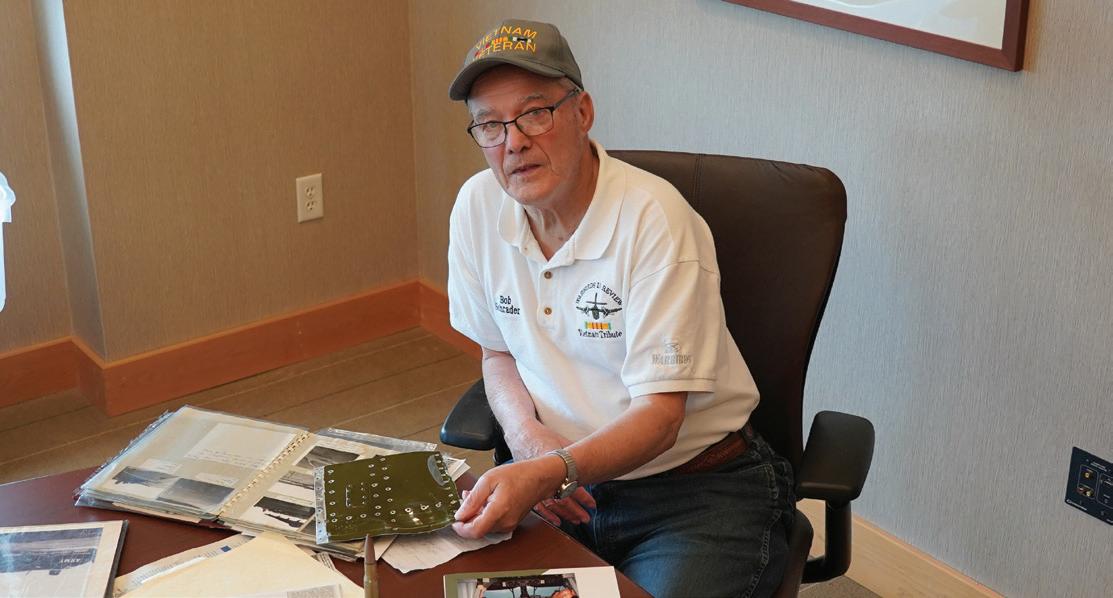
Through the eyes of Jim Sad, a Cass County Electric member, we reflect on the resilience and community spirit during the historic ice storm that left thousands in the dark.
It’s been nearly 300 days since the region was crippled with the worst ice storm the state has seen in over 25 years. From Dec. 25, 2023, to Jan. 5, 2024, thousands of CCEC members were without power for prolonged periods of time, often surpassing days and even one week. As we approach the one-year anniversary of the storm, we want to reflect through the eyes of a member who experienced some of the storm’s most extreme turmoil.
Jim Sad lives a stone’s throw outside of Fingal, North Dakota. Surrounded by amber fields of corn and a vast prairie sky, the property is a beacon of tranquility that Sad and his wife landed upon six years ago.
“We were living in Enderlin and were aware of the place because a friend of mine was interested in it,” Sad recalled. “Things didn’t work out for him to buy it, but
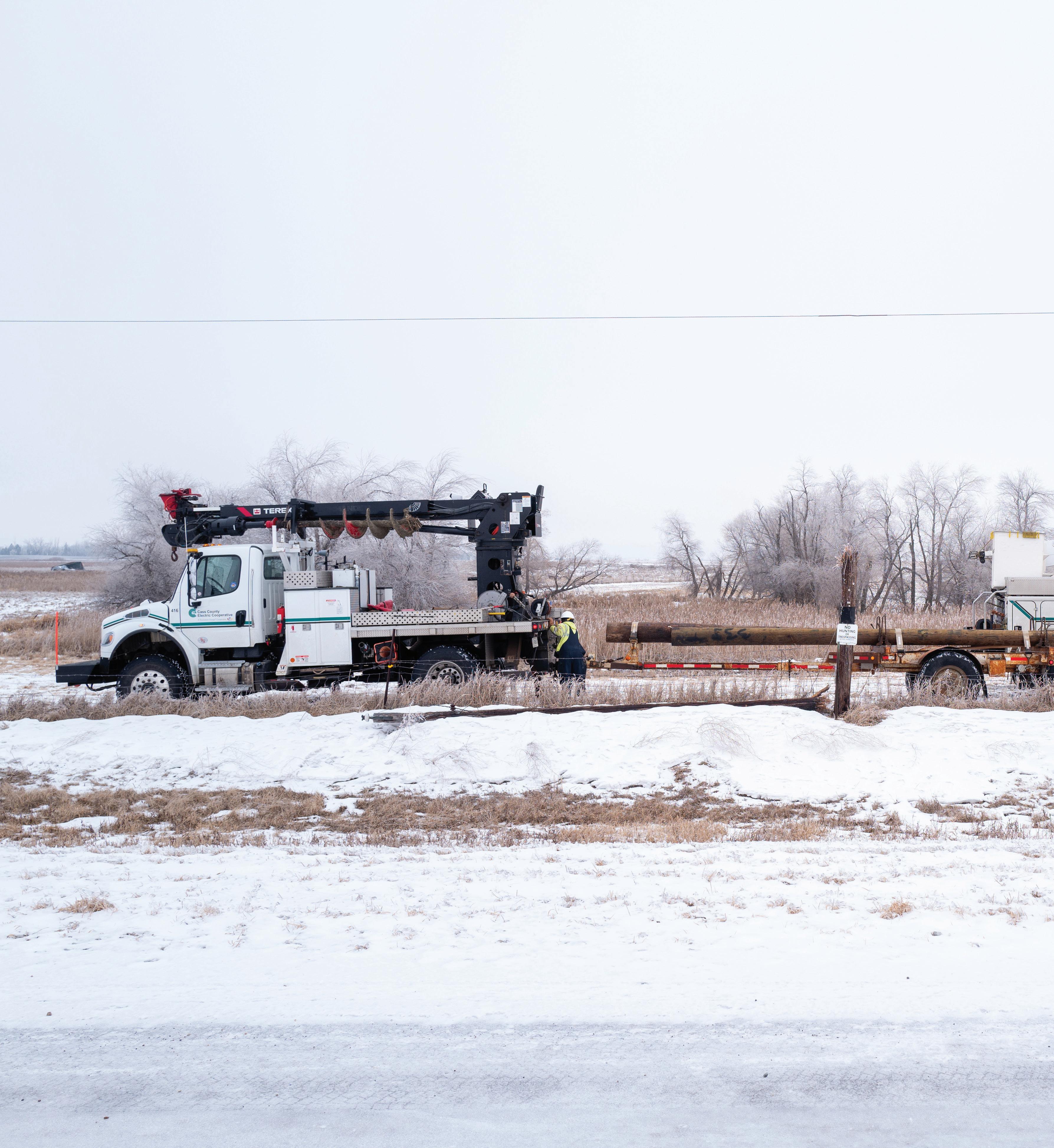
he referred the owner to us. The seller reached out to me, and we came out the next day. We put in an offer, and here we are.”
It’s served as a haven for Sad, his wife, two sons, and chickens, horses, and dogs from the hustle and bustle of modern-day society.
“It’s really been perfect,” he said. “We’re close enough to drive into town, but we get our own slice of peace and comfort.”
That changed on Christmas Day last year. Sad and his family experienced multiple outages over a nine-day span due to the holiday season ice storm. The longest of those stretches lasted seven consecutive days.
Just months after his mother’s passing, Sad and his family spent Christmas at his father’s house in Jamestown.
“It was our first Christmas without
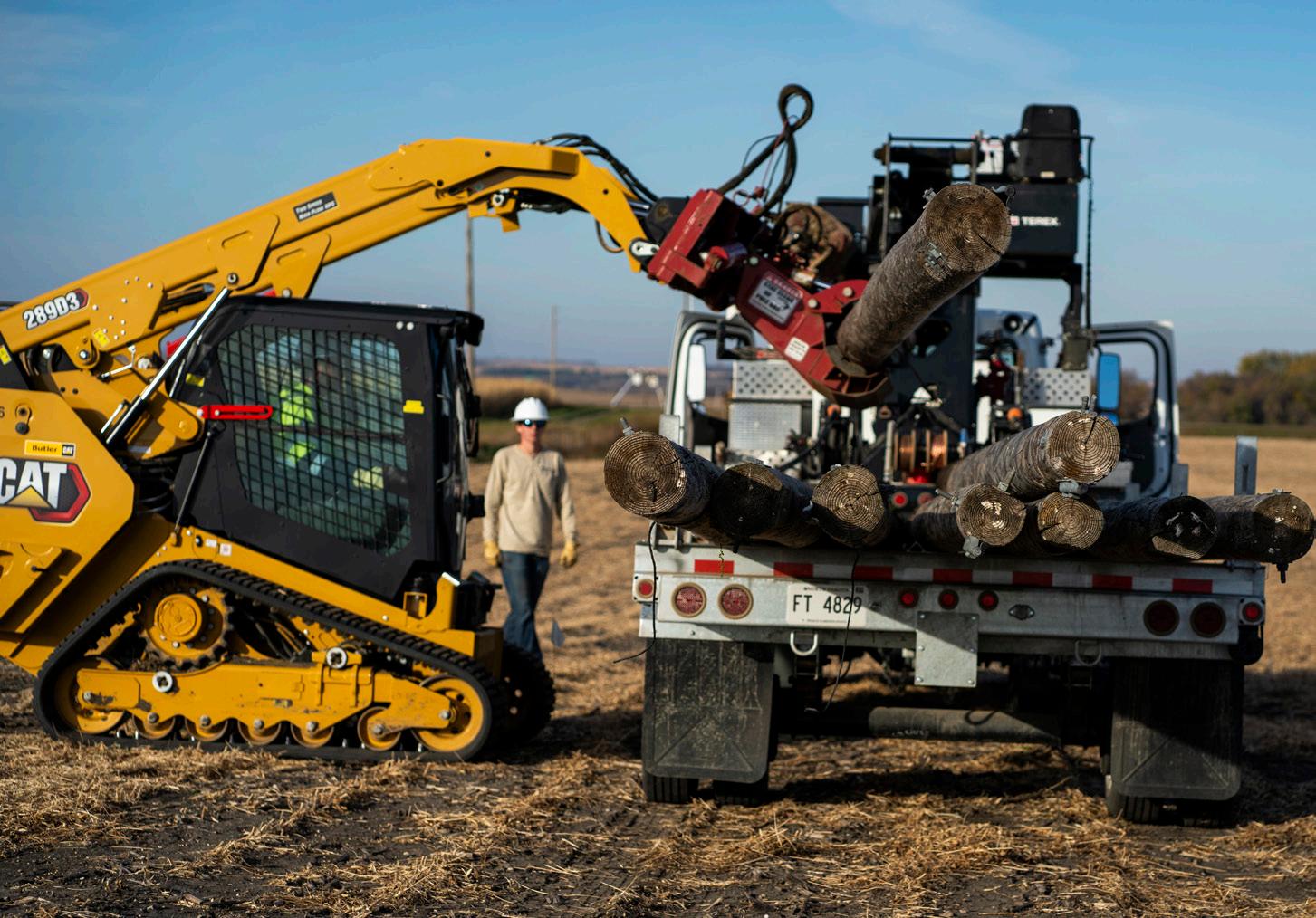
her, so the entire family wanted to be with Dad,” Sad said. “He’s a former city worker, so when the weather started to pick up, he was on alert.”
Sad monitored the radar but remained calm as the family weighed returning home. They returned home that evening with no difficulties on the road and to a house equipped with running electricity.
Then it hit
“We woke up the next morning to no power,” he recalled. “I wasn’t too concerned because we rarely get outages, but when we do, it’s a pretty quick turnaround. I made a call to Cass (County Electric), and they said they were aware and working on it, and life went on.”
Sad, who works at the sunflower plant in Enderlin, headed to work and received a call that power had been restored. He and his wife (who works in Valley City at a daycare) returned home to running electricity. Later that night, the power went out again.
“I called again, and they were on it,” Sad said. “We woke up the next morning, and things were good.”
Thinking they were in the clear, the Sads headed to work…only to return home to no power. Yet this time, things were not turning back on.
“That’s when we realized we were in it for the long run,” Sad said. “It was warm enough that we went two days without a worry.
We’d put sweatshirts on and use blankets, but we would play games with the boys. It was fine.”
Yet after 48 hours with no electricity, Sad had a decision to make.
“With a two- and four-year-old, we could tell it was a little too cold,” he said.
Sad’s wife took the two boys to her parent’s place in East Grand Forks for the weekend before venturing to Jamestown on Monday to stay with Sad’s father so she could still commute to work. In the meantime, Jim stayed at home to hold the fort down and take care of the animals.
“If you’ve got animals, it’s your duty to take care of them and keep them fed and hydrated because they can’t fend for themselves,” Sad said.
Sad was able to make do with a small generator for a few days. But after 48 more hours without power, he realized he’d need something bigger. After taking to Facebook for help, he drove to West Fargo to pick up a larger generator that a friend had offered to lend. While stopping in Casselton on the way back to fill up a gas tank, he came upon a Cass County Electric truck.
The person inside? Former CCEC VP of Member and Energy Services and current CEO/ President Paul Matthys.
“I approached him asking if he or his team needed food, water, or anything else,” Sad recalled. “He shared with me that he was actually in charge of line patrol in my area. We talked about generator safety, and he gave me his cellphone number and told me to reach out if I had any questions.”
Initially not planning on reaching out, Sad felt inclined to after seeing the around-the-clock work of CCEC’s lineworkers to restore power.
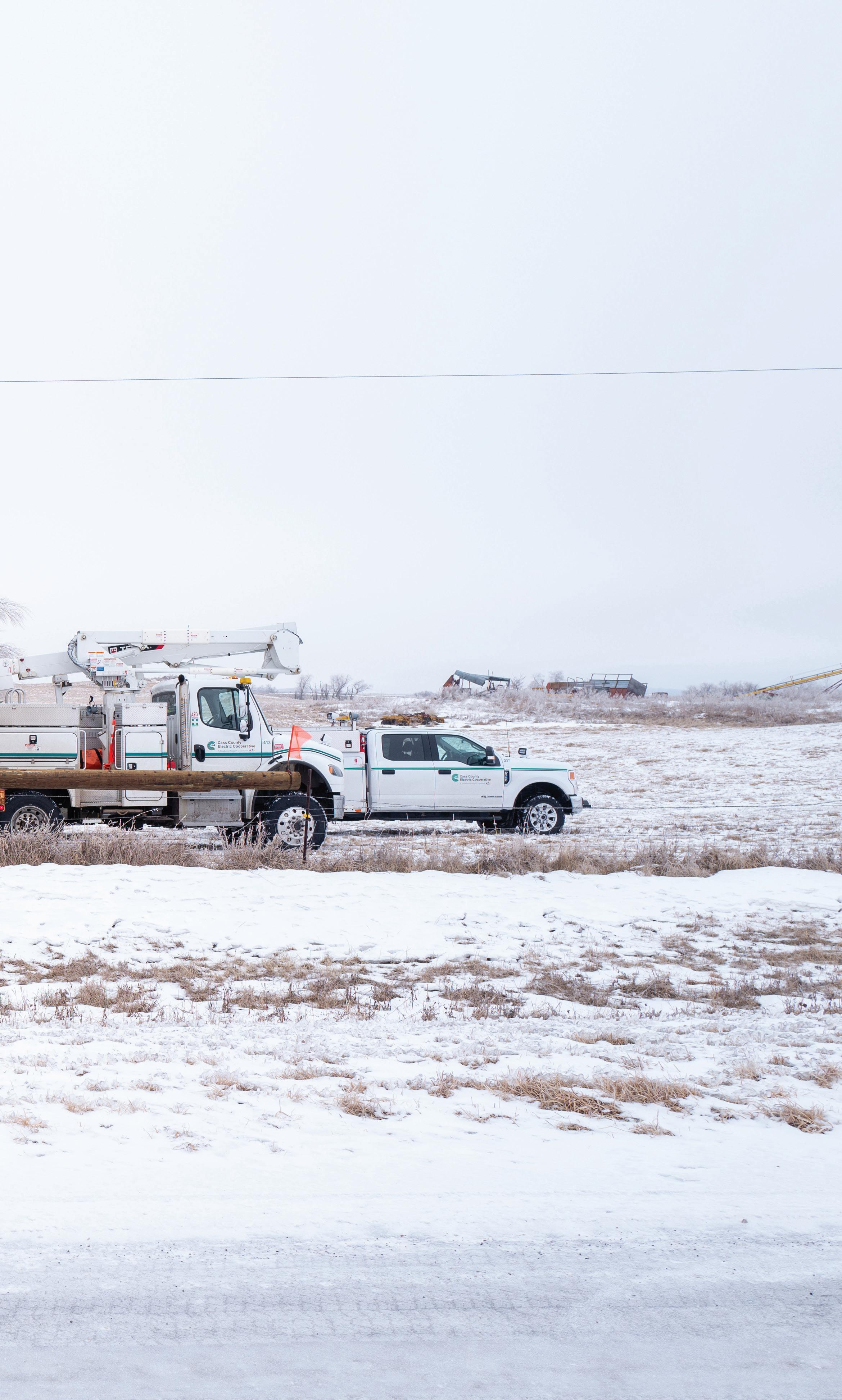
“I think Paul felt my sense of urgency as time went on,” Sad laughed. “I texted him once a day to three times a day, to even more. He was very honest – he didn’t tell me what I wanted to hear, he didn’t sugarcoat things, and I appreciated that.”
As CCEC lineworkers continued their pursuit, Sad would drive up and down the line to monitor progress. As the only member on his stretch of line, he understood the importance and prioritization of restoring as many people as possible as soon as possible.
“Paul gave me a map, and I’d drive up and down the line,” he said. “He’d text me updates of where lineworkers were and as accurate of estimates he could give.”
Nine days and nearly $1,000 of gas for his truck and generator later, Sad and his family were able to be under the same roof again.
“I was never really worried because I knew they would get it back on, but it was stressful; it’s a long time to go without seeing your wife and kids,” he said.
As he reflects on the monumental storm, Sad appreciates the diligence of CCEC’s team during even the toughest of circumstances.
“I had two objectives: keep my family safe and make sure my animals live,” he said. “To see the extent to which CCEC’s lineworkers went to help us was incredible. They’re truly not in it for themselves but for their communities.”

The property taxes you pay play a crucial role in the growth of your community, funding essential services such as schools, public safety, infrastructure, and community amenities like parks, pools, and libraries.
If this proposal passes, North Dakota would need to allocate an additional $1.575 billion each year to cover property taxes and maintain these critical services. Currently, there is no well-developed plan in place to generate the estimated $1.575 billion needed annually to support these services.
This shift would also reduce local control over budgets. Local officials, who are more familiar with the specific needs of your community, would lose decisionmaking power to state-level authorities.
From ice storms to power outages, Cass County Electric Cooperative is committed to keeping members safe through prevention, preparation, and the lessons learned from past storms.
Last year’s ice storm was the worst the region has seen in over a quarter of a century. And while the chances of another storm of that magnitude occurring in the near future are slim, weather in our region is as unpredictable as it comes. And while we can’t control the weather, we can control how prepared we are in case of a major storm.
Cass County Electric Cooperative (CCEC) prides itself as a leader in safety for its employees and members. That includes storm preparation, response, and preventative maintenance that keeps you as a member at the forefront of the picture. It’s also critical for members to take proactive steps to ensure preparedness in the event of a major ice storm that causes the power to go out for an extended period.
“The first step to proactive safety is your own well-being,” CCEC Manager of Systems Maintenance and Fleet CJ Erickson said. “It’s critical to prepare for the worst.”
Safety for one’s well-being starts with over-preparing essential resources such as food and water, as well as planning logistics for heating, sump pumps, and livestock for farmers.
“If we have an extreme weather event forecasted and you suspect you may be out of power for a day, plan to have enough resources for three to four days,” Erickson said.
A former lineworker for 17 years, Erickson stresses the importance
of investing in a generator.
“If you’ve got the financial means, it (buying a generator) can be a lifesaver.”
Yet, while generators can keep the lights on during a severe outage, they can be deadly to both users and lineworkers if not used or installed properly.
“Always contact a licensed electrician to install your generator or if you have critical maintenance questions,” Erickson said. “The consequences of not doing so can be tragic.”
Refer to the following safety and maintenance tips for your generator.
Do
- Keep all standby, portable, and inverter generators at least 20 feet from your home or barn.
- Direct exhaust from your generator away from your home or barn.
- Make sure to start and stop generators when no electrical loads are connected.
- Ensure your generator is properly grounded. Use a ground fault circuit interrupter (GFCI) to prevent electrical shock injuries.
- Keep portable and inverter generators dry and out of rain/ snow.
Don’t
- Connect a generator directly to your home’s wiring without the appropriate transfer switch installed.
- Plug a generator into a regular
household outlet.
- Operate a generator in a closed space.
- Fuel a generator while it is operating.
- Overload generators.
- Touch hot parts of the generator while in use (muffler or engine components).

Remember – safety starts and ends with you! Never hesitate to reach out to CCEC with questions.
CCEC’s proactive and preventative approach to storm safety
Last winter’s ice storm will go down infamously as one of the worst our region has seen.
“These are rare measures,” Erickson said. “While there weren’t as many poles down as there were in 1997, the footprint of the damage was much greater.”
While epic ice storms are rare, CCEC’s team always takes proactive approaches to best equip the cooperative and its members for them if they do occur.
“We’re a sound cooperative that has a lot of experience on what works and what doesn’t,” Erickson said. “We can be proactive about maintenance because of our size and experience.”
That includes annual pole testing and overhead maintenance. CCEC tests 4,000-5,000 poles each year and has information on each pole’s age, model, and any previous issues.
“In a two-year span, we survey our entire service territory of overhead,” Erickson said. “Standard maintenance also includes vegetation management (trees, bushes, etc.) and animal protection measures.”
Erickson and his team know the ins and outs of each corner of CCEC’s service territory. For example, they’ve found that some older poles, given their build and coating, are more sturdy than modern poles.
“Some of our oldest poles are some of our best poles,” he said. “We had poles that were installed in 1949 (that still pass regulation) that were standing during the storm and ones put in just weeks prior that were on the ground.”
While CCEC took all appropriate approaches in response to last year’s storm, new lessons were learned, and strategies were implemented. Most notably, the cooperative has received approval from FEMA of five grant requests to bury 11 miles of line underground in the western part of CCEC’s service territory.
Being proactive isn’t just important during crises; it’s the day-to-day expectation for CCEC’s team.
“We’re always looking ahead and learning from previous experiences,” Erickson said. “We take pride in keeping the lights on, and it’s our duty to be prepared for external circumstances that infringe on that.”
We work hard to provide the most reliable service possible. Rest assured, if the power is out, we are on it!
The length of time it takes to restore your power depends on several factors, including the:


Extent of the storm’s destruction
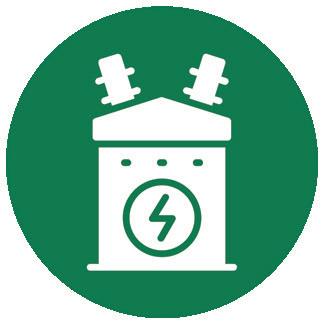

Severity of utility equipment damage Number and extent of outages

Accessibility to damaged equipment
Stay safe until power is restored:
• Stay far away and keep others away from downed power lines, which could be live and deadly. Immediately report it to 9-1-1.
• Never locate a generator inside of your home.
• Monitor and report outages using the Cass County Electric mobile app.

Prepare for a storm by gathering these items:


Nonperishable food

Portable phone charger

Prescriptions

Battery-operated radio

Flashlights

Extra batteries

Pet supplies

Blankets

Warm clothing

First-aid kit

Hand sanitizer
Thank you for your patience during outages. When the lights go off, we are working safely and efficiently to restore power. The safety of our employees, as well as those we serve, is our TOP priority.

Scan here for more safety tips!
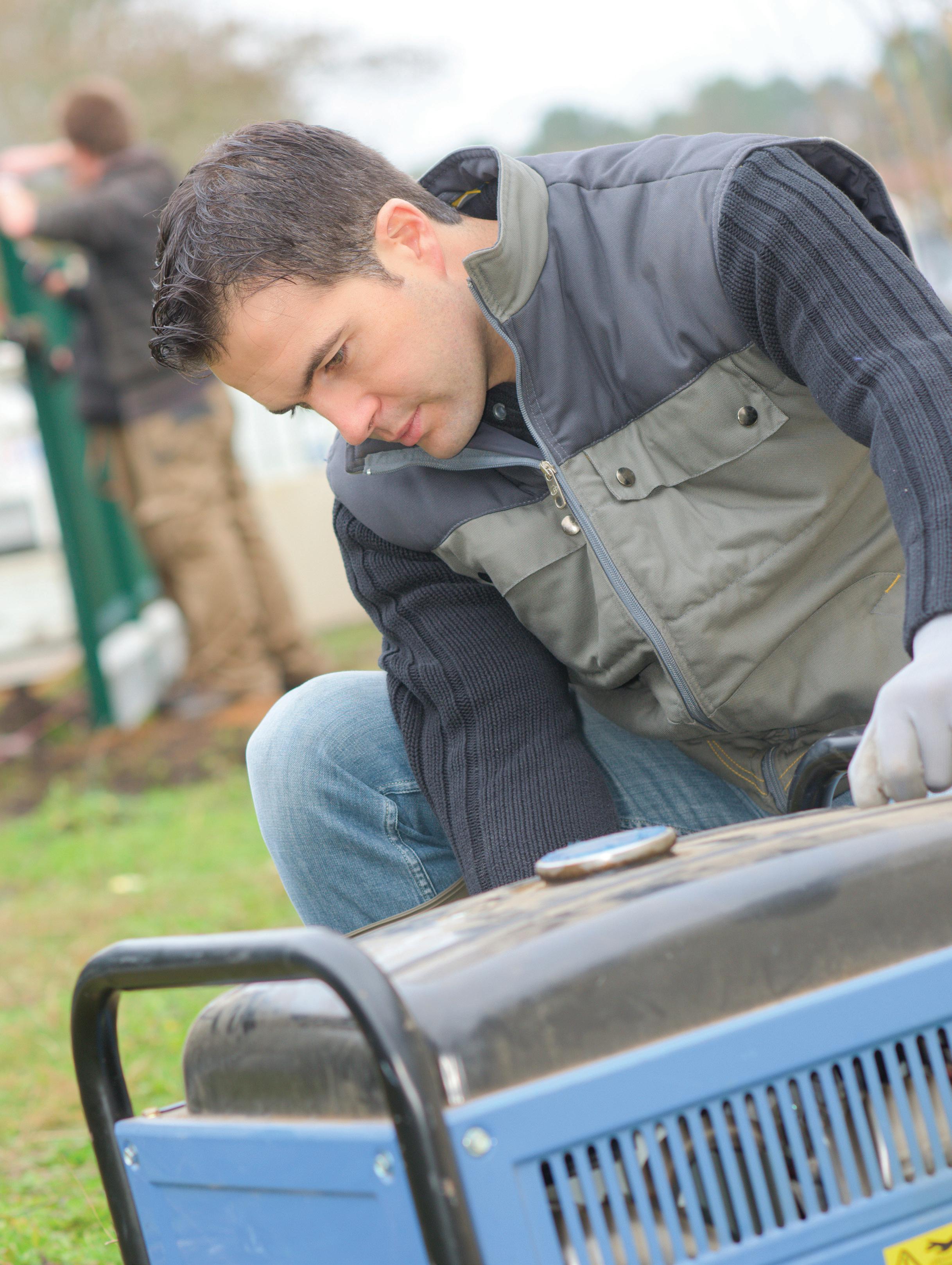
Shopping for a generator? Do a little homework first.
Generators are classified by how much power or watts they can produce. That wattage measurement is important because it determines how many devices you can power. According to Consumer Reports (CR), the typical home requires 5,000 watts to cover the basics.
When considering which generator to buy, decide what you can’t live without when the power is out. Then add up the wattages to get an idea of how much power you will need.
For example, a refrigerator typically takes 600 watts to run; a sump pump requires 750 to 1,500 watts; a portable heater can take 1,500 watts; and lights can require from 60 to 600 watts (depending on how many you power and the size of your home).
Safe Electricity and Cass County Electric Cooperative offer background on four types of supplemental power sources:
1. Portable Generator
Because these usually run on gasoline, they can be extremely dangerous since they can produce carbon monoxide (CO). Because of that, never run these
indoors or in an enclosed space and always keep them at least 20 feet from your home when operating them. Additionally, do not use them in damp or wet conditions. Some newer models feature a built-in CO sensor that triggers an automatic shut-off feature if it detects CO buildup. Other advanced models are designed to emit less of these fumes; both of these safety features help to save lives. Prices range from $400 to $1,000.
2. Inverter Generator
This type of generator has a more complex engine than its portable cousin. Because of that, inverter generators usually cost more than portable versions. They are much quieter than portable generators since they throttle up and down to match demand (instead of running at constant full power). They also boast more advanced exhaust systems, which also helps with noise levels. Inverter generators typically cost $500 to $4,000, and if you pick this kind of generator, you should follow the same safety precautions you would with a portable version.
3. Standby Generator
This is the most expensive type
of generator and models range from 5,000 to 20,000 watts. Standby generators are also the most convenient, since they are permanently stationed and they kick on automatically when the power goes out. They run on propane or natural gas and cost $3,000 to $6,000, not including installation. Installing them is definitely not something you can do yourself; they should be installed by an experienced electrician.
4. Portable Power Stations
These stations don’t use gasoline or propane; instead they are powered by a battery that can be charged by electricity or by a solar panel. They cost more than traditional portable generators at $750 to $3,000. They are extremely quiet and they don’t produce fuel emissions so you can use them indoors. The downside is they don’t power as many appliances as portable generators and they don’t run for an extended period of time.
For more information about electrical safety, visit CassCountyElectric.com/safety


Hometown: Fargo, ND
Tell us about your education: I recently graduated from MSUM with a bachelor’s in computer information technology. I also have an associate’s degree from MSCTC.
Tell us about your career:
For over a decade, my brother and I ran a legal process-serving company in the Fargo/Moorhead area. It was an extremely interesting job, and I learned many valuable things. However, during the pandemic, I decided to go back to school and finish getting my degree. After graduating in May 2024, I spent the summer working for a robotics company and doing an internship here at CCEC before accepting this position.
Tell us about your family: I have one older brother and
parents who still live in North Fargo. I’ve recently moved into a house in south Moorhead with my girlfriend, her kids, and my 16-year-old cat Dudley.
Hobbies:
I enjoy climbing at Fargo Climbing, tinkering with electronics, finding and cooking new recipes, hiking new trails, listening to music, and going to concerts.
If you won the lottery, what would be your first purchase? I would book a trip with all my family members to somewhere fun like Paris or New York City and take everyone out to an expensive restaurant followed by a concert.
What’s your favorite season? Spring
What’s your favorite food? Pizza and fajitas

Join us on the adventure of a lifetime. On the Electric Cooperative Youth Tour, you’ll do it all. You’ll explore monuments and museums, meet with members of Congress and get an up-close look at where our country’s laws are crafted. You’ll stand on the Gettysburg Battlefield, walk the halls of George Washington’s iconic 18th-century mansion and witness ceremonies honoring the men and women who fought in uniform for this great nation. For one jam-packed week, you’ll be immersed in the cooperative spirit that built and sustains our great nation. And all expenses are paid by your local electric cooperative!
Cass County Electric Cooperative’s directors serve as liaisons between fellow members and the cooperative executive staff, providing guidance and oversight on cooperative finance and operations. Directors provide the vital service of voicing the membership’s needs and upholding the cooperative value of democratic member control.
CCEC members in Districts 1, 6, and 8 interested in becoming a director should contact our executive assistant at 701-356-4405 or directorelections@kwh.com for a director election petition packet.
Interested members must return all required paperwork to the cooperative by Jan. 15, 2025. Members
will vote for new board members at the cooperative’s April 15, 2025, annual meeting.

Scan here for more info!
Candidates interested in running for three-year terms for positions in Districts 1, 6, and 8 must be bona fide residents of the district in which they are seeking directorship. Below are the current directors of these districts.
District 1 Paul White (I) Stirum
District 6 Glenn D. Mitzel (I) West Fargo
District 8 Kalvin Hoff (I) Fargo
Scan the QR code to learn how to run for the board or to view the district map in more detail.
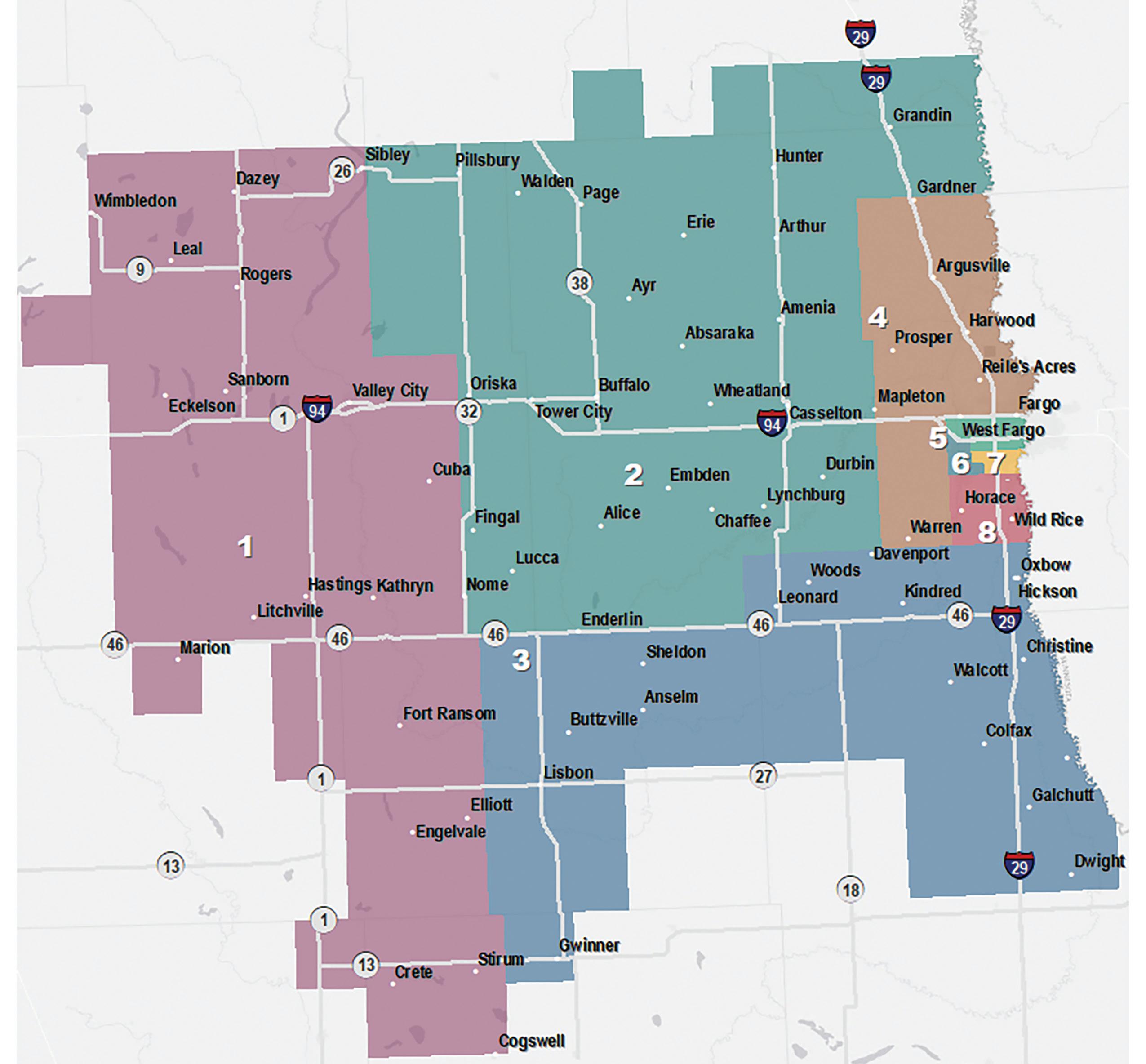

Check out our Pinterest page for more recipes!


As the holidays approach, we’re feeling a touch of nostalgia and have dug into our recipe archive to bring you some timeless, easy-to-make dishes that remind us of home and the warmth of growing up. Fun fact: We’ve been sharing cherished recipes in our Highline Notes magazine since 1952!
Ingredients:
1 pound hamburger
1 pound bacon, cooked and crumbled
2 large cans pork and beans
1 can kidney beans, drained
1 can butter lima beans, drained
1 cup onion, chopped
1 cup ketchup
Ingredients:
(12 oz.) corkscrew pasta, cooked, drained and rinsed
1 cup mayonnaise
1/2 cup Wish-Bone Italian dressing
1 small can chopped green chilies, drained
1 teaspoon chili powder
1 teaspoon ground cumin
1 can red kidney beans, rinsed and drained
1 can corn, drained
Ingredients:
2 pounds beef stew meat
1 onion, chopped
1 can cream of mushroom soup
1 can cream of onion soup
1 can sliced mushrooms, drained
1/4 teaspoon pepper
1 package cream cheese, cubed
Ingredients:
1 cup vegetable oil
1/2 teaspoon garlic powder
1 package Hidden Valley Ranch (original)
1 teaspoon lemon pepper
1 package oyster crackers
3 teaspoons white vinegar
1 teaspoon liquid smoke
1/4 cup brown sugar
1 teaspoon salt
1 teaspoon pepper
Preparation:
Put in a slow cooker, cover, and cook on low heat for at least 4 hours or 2 hours on high.
1 tomato, chopped
1 green pepper, chopped
1/2 cup chopped celery
1 teaspoon dried parsley
Preparation:
Cook pasta as directed, then drain and rinse with cold water until cool. Mix mayonnaise, Italian dressing, chilies, chili powder, and cumin in a large salad bowl. Toss with pasta and the remaining ingredients. Cover and chill.
1 container sour cream
6 cups egg noodles, cooked
Preparation:
Put beef, onion, soups, mushrooms, and pepper in a slow cooker, cover, and cook on low heat for at least 8 hours. Stir cream cheese into beef mixture until melted. Stir in sour cream. Serve beef mixture over egg noodles.
Preparation:
Warm oil on the stovetop while mixing in other ingredients. Pour over the oyster crackers and mix well. Bake on a cookie sheet at 250° F for 20 minutes. Cool and refrigerate.

Did you know washers and dryers account for around 10% of household energy consumption? Keeping them in top condition helps your clothes smell fresh and keeps your energy bills in check. Here’s a quick guide to maintaining your washer and dryer.
Maintaining your washing machine is key to conserving energy. A dirty machine works harder, consuming more power. Regular cleaning can help it perform at its best. Start by leaving the door open after each wash to let moisture escape, preventing mold and bacteria from forming. Wipe down the seals and clean the filters to prevent blockages that could force the machine to use more energy.
Occasionally give your washer a deep clean. For top-loaders, soak key parts in hot water, vinegar, and baking soda solution. Front-
loaders need special attention to the drum and pump filter to remove any residue. This not only keeps your machine running smoothly but also ensures it operates at its most energyefficient level.
Just like your washing machine, your dryer requires regular maintenance to operate efficiently and safely. A clogged vent restricts airflow, forcing your dryer to run hotter and longer, using more energy. Lint buildup is a major concern—cleaning your lint trap after every load is crucial to avoid increased drying times and fire hazards. Deep clean your lint screen every few months with hot, soapy water, especially if you use dryer sheets, which can cause waxy buildup.
Your dryer vent should be cleaned annually to reduce the risk of fires. In the U.S., a dryer fire occurs roughly every 30 minutes, often due to clogged vents.
Using vacuum attachments and brushes, clear the vent of lint and debris, and always ensure your vent cover is free of blockages to avoid potential hazards. This also prevents moisture from returning to your home, which could lead to mold and mildew.
The dryer drum sees the most action and should be cleaned regularly to maintain performance. Unplug the dryer, spray the drum with a nonflammable mild detergent, and wipe it down with a microfiber towel. Make sure to dry it completely to avoid any residual moisture from fabric softeners or dryer sheets.
Regular cleaning of your washer and dryer not only keeps them running efficiently but also plays a major role in conserving energy. A well-maintained machine uses less power, reduces drying and washing times, and ultimately lowers your utility bills.
All ads must be 40 words or fewer and will be abbreviated following our guidelines. No real estate or commercial ads will be accepted. Ads are published for members at no charge as space permits on a first-received, first-printed basis. Ads are due by the 10th of the month prior to publication. Ads are not published in the April or December publications. Members may submit only one ad per issue. Editor reserves the right to edit or reject any ad. Email ads to: ccec@kwh.com
For sale
12-row 22” single shank row crop cultivator Alloway cutaway & rolling shields 3030. JD all roll crop header 653 converted to 8-22. 218-779-2882
8-row 22” Clark corn header, kept inside. Universal platform Pickett bean equipment 21’ 4-bar field edible bean pickup. 701-238-4261
Used steel T posts. 5 ½’ & 6’ long. 701261-6308
Rifle & pistol reloading dies: RCBS rifle 30/06, .250 Sav, .300 Winchester Mag, 8x57 Mauser, .243 Winchester Pistol, .44 Special Mag. $120. 701-799-1114
Lakeside Foundry laundry stove (early 1900s). Grade school desk (1950s). Air-operated parts washer. Hallmark Christmas ornaments (1990s), newin-box. 1980s/90s sports cards. Tonka toys (1960s). 217-549-7846
Chaise lounge, reclines, tan-gold suede, great cond., $200. Rocker recliner, swivel hunter suede, nice cond., $50. Kitchen table, ends pop up to double size, navy stain, two chairs, $125. 1984 club car electric, 4 y/o, metallic grey, has roof, stored inside, nice cond., $2,500. 701-799-3028
Like new, 7’ leather sofa, $200. MTD 10 hp 24” self-propelled snow blower, loaded, has all options, exc. cond., $250. 2006 Chevy Silverado 4 door, 4 wd, good cond., $7,500. 701-541-6325
Simplicity DLX riding tractor, new 20 hp engine at 600 hrs. 42” snowblower, 50” mower deck, rear wheel chains, $3,500. 60” JD power broom fits JD X Series, new brushes & bearings, $2,700. Murray 30” riding mower w/ good 10 hp TEC engine, $750. 701-2611647
2001 Buick Century Limited, 189k, silver, 3100 V6, everything in working cond., lots of features for age, great car, downsizing, $2,400. 701-866-5852
Small square bales of horse-quality grass hay, wheat straw, & soybean straw. 701-238-2933
Maytag white elec. top load washer (3.9 cu ft) & white elec. dryer (7 cu ft), BO. Oak roll-top desk w/keys, 45” H x 24” D x 36” W, $100/OBO. 701-793-1065
Huffy 3-speed bike, new tires, $75. 701-361-7333
Inspected Bison meat by the pack, qtr. or half. Grass hay horse quality mid & small squares. 701-238-1893
2003 Harley Davidson Fatboy (100th anni.), $7,000. 13,000 miles, fuel injected, detachable windshield, screaming eagle pipes, lockable saddlebags, chrome swingarm, pics avail. 701-361-2551
Hunting camouflage clothing from Cabela’s & Columbia, exc. cond. 2 Quad coats XL, $25/ea. Quad Wader jacket XL, $45. Bibs XL, $25. Blaze Orange Remington shirt L, $10. Blaze orange camo jacket, $15. White camo shell jacket 2X, $15. Goose down vest XL Tall, $20. 303-319-8485
Brown Nod-a-way baby crib, 28” x 51” w/ mattress & sheets, side slides up & down. 701-967-8963
Old house parts, 1900. Staircase banister & spindles, 1” oak stair risers, many doors w/ unique doorknobs & hardware, unpainted door & window woodwork, parlor columns, porch posts, theater seats, 5 HP gas Pacer centrifugal pump, runs good, $70. 701-367-4837
8’ x 12’ wooden storage sheds, 16” on center studs, rafter, floor joists; pine paneling siding, gable shingled roof, dbl. door opening 56” W x 71” H, $3,000. No delivery, but will load on flatbed trailer. Pics avail. 701-8405438.
Rear rubber cargo mat, from 2018 Nissan Pathfinder, very good shape, $40. Cash. 701-793-5859
Igloo Polar 120 cooler. $50. Airhead Big Mable, like new, $100. Luverne chrome grill guard for Chevy/GMC 2007-2010, 2500HD, $250. Makita scroll saw SJ401, $100. SandPro pool pump/filter $50. American Wick Kerosene heater model AWHC 2230 w/ new wick, $50. 701-552-1180
Dining room table, 5’ x 3’, 6 chairs, dk. wood tone, exc. cond., $600. 701-2326485
Beige fabric, 5 y/o England brand hide a bed sofa queen w/ bed air mattress w/ working elec. pump, good cond., $600. Pride elec. scooter, 2 y/o w/ 700 hrs., runs well, $700. 701-730-5224
Inogen One G5 portable oxygen concentrator, 1 y/o, delivers 6 liters, blk case, $1,200. Pinnacle Stairlift 6 m/o beige chair, $1,300. Pride Mobility portable power chair, go chair in red, 1y/o, Pics avail., $1,500. 612-760-2211
Front wheels & tires for 4850JD front wheel assist. 701-238-1893
Bedroom dresser w/ attached mirror, 60” L x 18” deep x 30” H. 701-793-1065
Farm cats. 701-238-1893

Be a Santa to a Senior
a

• Choose a bulb from the tree at CCEC (4100 32nd Ave S, Fargo) between Nov. 25 and Dec. 16 (7:30 AM - 4:30 PM)
• Purchase the requested gift(s) listed on the bulb
• Return the bulb and unwrapped gift(s)